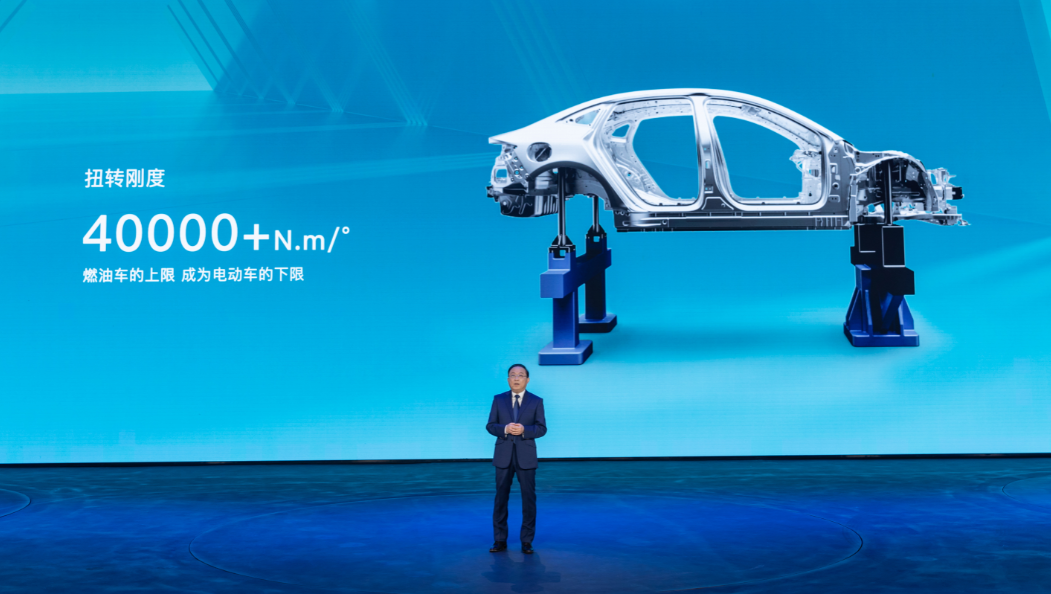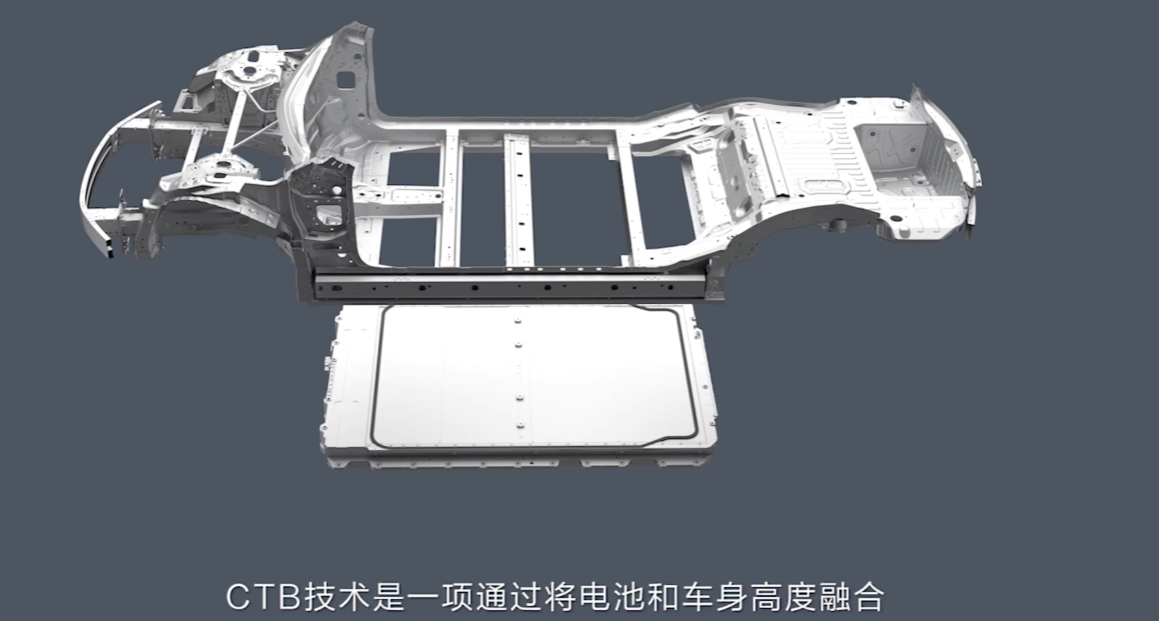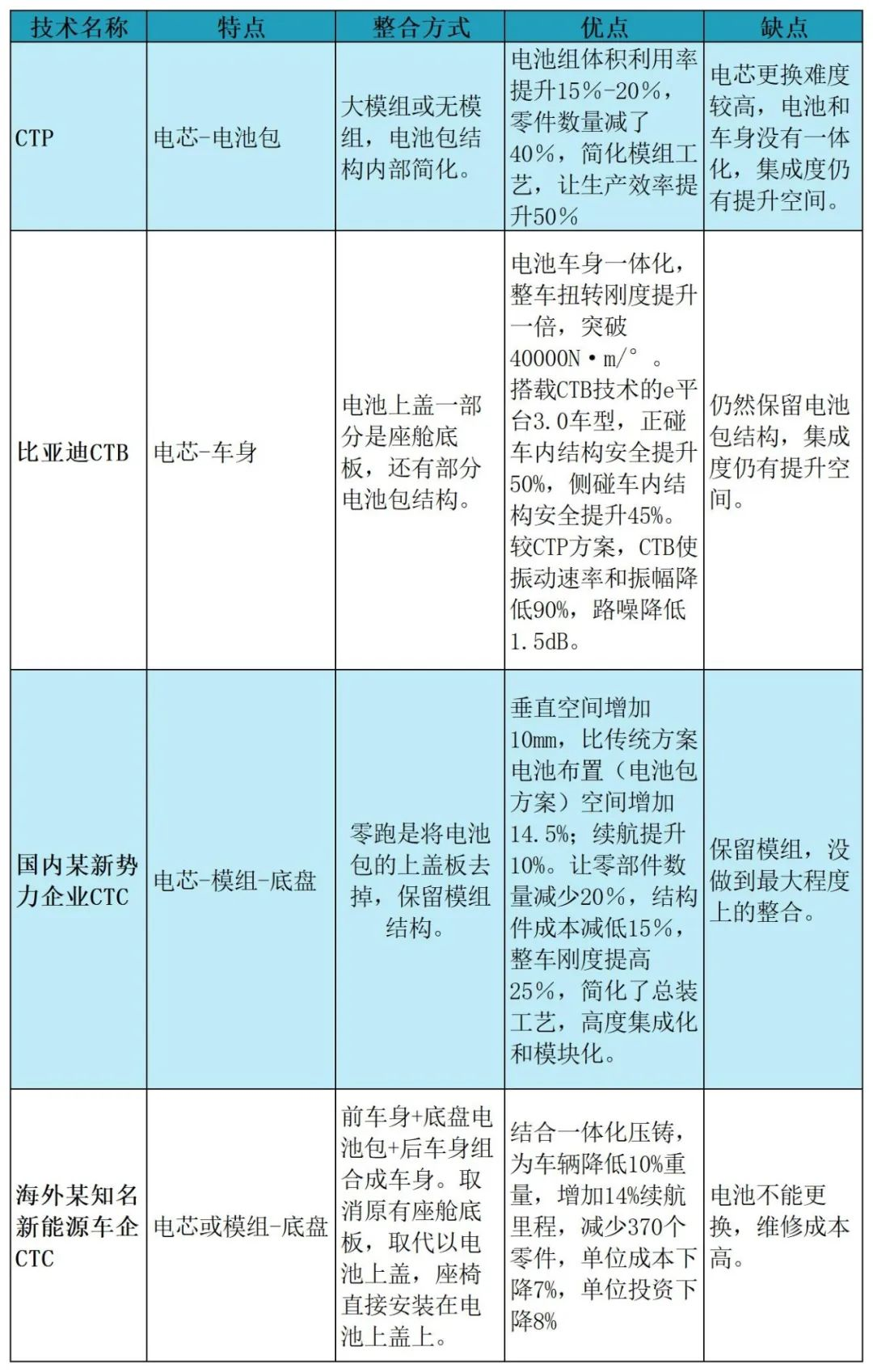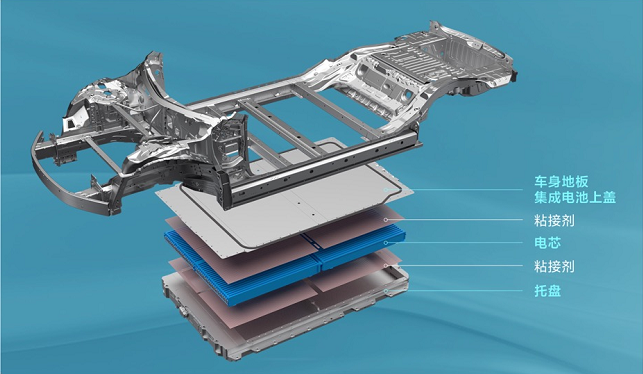CTB Battery Technology from BYD: Integrating Cells into Car Body
Author: Lingfang Wang
Editor: Kaijun Qiu
Just as the shock from the blade battery has not yet subsided, BYD has released CTB battery technology.
On May 20th, BYD released its CTB battery and vehicle integration technology, and the first CTB-equipped vehicle model, the Hanbao. With only a lithium iron phosphate battery, the Hanbao can achieve a maximum range of 700 kilometers, further breaking the upper limit of range for lithium iron phosphate battery-powered passenger cars.
This adds another heavyweight player to the battery and vehicle integration technology. Previously, well-known international automaker’s 4680 CTC battery technology, domestic startups’ CTC battery technology, and domestic battery companies’ non-module CTP technology have made battery structure innovation a hot topic.
What is BYD’s CTB battery and how does BYD apply its logic in power batteries? What is the future development path? This article attempts to answer these questions.
BYD Battery Technology “Transformed”
What is CTB?
At this BYD press conference, Liang Yubo, executive vice president of the Group and dean of the Automotive Engineering Research Institute, appeared to explain.
Liang Yubo introduced that CTB (cell to body) technology is based on CTP (cell to package) and integrates the battery cover with the car body floor, evolving from the original battery pack “sandwich” structure to the whole car’s “sandwich” structure, a technology that integrates battery cells directly onto the car body.

This small improvement significantly improves the overall performance of the vehicle.
(1) Safety Significantly Improved
The structural strength of the CTB blade battery pack has been breakthrough, passing the extreme test of a 50-ton heavy truck rollover.
For electric vehicles equipped with CTB technology, the torsional stiffness of the vehicle body can easily exceed 40,000 Nm/degree. As Liang Yubo put it, “This high torsional stiffness rivals that of million-dollar luxury cars, and turns the upper limit of fuel vehicles into the lower limit of electric vehicles.”
The first CTB-equipped model Hanbao, increased the overall torsional stiffness by 70% and the torsional stiffness of the vehicle body reached 40,500 Nm/degree.

Adopting CTB technology has increased the overall strength and stiffness of the vehicle, thereby improving the safety performance. Data provided by BYD shows that the e-platform 3.0 model equipped with CTB technology has improved its collision safety performance by 50% for frontal collisions and 45% for side collisions.(2)Improved Driving Experience
High torsional stiffness not only improves safety, but also means that the vehicle deforms less and responds faster under various conditions, resulting in a significant improvement in cornering handling experience.

BYD has provided test data for the Dolphin model. This car passed the elk test at a speed of 83.5 km/h, a single-line test at a speed of 133 km/h, and the maximum lateral stability acceleration in steady-state turning is 1.05 g, reaching the level of a sports car.
(3)More Comfortable Driving Experience
CTB technology integrates the car body floor with the battery cover, effectively suppressing car body vibration and improving NVH level, reducing vibration rate and amplitude by 90% and reducing road noise by 1.5 dB compared to the CTP solution. CTB’s application enables the vehicle to handle speed bumps and bumpy roads with ease, providing a smoother and more comfortable ride.
In addition, CTB technology reduces the battery’s vertical space occupancy, increasing the vertical seating space by 10mm under the same vehicle height dimensions, further releasing the potential for improved interior space, allowing users to have a more comfortable driving experience in a low-profile designed car.
How is CTB Possible?
How can combining the battery cover and the car body floor further improve safety and performance?
(1) Thanks to the Overlay of CTB and e-Platform 3.0
CTB was born based on the blade battery CTP.
The unique long-blade shape of the blade battery is horizontally placed end-to-end on the battery pack tray. Due to the strong structural strength of the blade battery itself, it can be used as the structure component of the battery pack or even the whole vehicle.
In the CTB battery pack, rows of blade cores form a structure more like a structural steel frame, with even pressure distribution, similar to honeycomb core, composed of the top and bottom covers to form a honeycomb-like structure.
The characteristic of honeycomb structure is that it can achieve higher stiffness and strength with the same weight.
Therefore, the CTB battery pack can withstand a limit pressure test of 50 tons.
In the traditional structural design of electric vehicles, to protect the safety of batteries, the structure of the vehicle’s power transmission system is broken, resulting in poor transmission and increased safety risks in extreme collision situations.
CTB technology improves the integration of the entire vehicle and the battery,applying the evenly distributed force characteristic of the blade battery to the car body as part of the car’s power transmission and force-bearing system, which can transmit and absorb energy.
Of course, it is the birth of the CTB technology that allows BYD’s e-platform to evolve in accordance with it.On the BYD e-platform 3.0, the body floor crossbeam is connected left and right, and uses a closed-loop roll forming design, greatly improving the lateral impact energy transfer and body structure stability. Thanks to the blade battery and battery pack honeycomb aluminum structure, the battery can serve as an important component of the power transmission structure, transmitting and absorbing energy, thereby enhancing vehicle safety.

In addition, the e-platform 3.0 adopts a power transmission structure designed specifically for pure electric vehicles, which achieves power distribution and rapid dispersion of collision energy:
Upward power transmission path: Achieves force transmission to the A-pillar, increasing the uniformity of forward wall barrier force;
Middle power transmission path: Reduces the height difference between the longitudinal beam and the floor by shrinking the longitudinal beam inside, designs a ring-shaped power transmission structure, improves the smoothness of power transmission, and enhances the collision stability of the root of the longitudinal beam;
Lower power transmission path: Equipped with a full-frame sub-frame, adding a power transmission path that guides power transmission to the rear longitudinal beam.
The integration of blade batteries with high-strength body structure creates ample space for energy absorption and a smoother energy transfer path upon collision. As a result, the cabin deformation is greatly reduced, further lowering the casualties of collision accidents.
Torsional stiffness is an important parameter that measures vehicle performance, which refers to the ability of the body to resist elastic deformation when subjected to external forces. The higher the torsional stiffness, the higher the comfort, handling, and safety of the vehicle.
The application of e-platform 3.0 powertrain and CTB battery-body integration technology deeply reshapes the entire vehicle structure, allowing the vehicle to achieve a 50:50 front-to-rear weight distribution, providing a strong foundation for stable handling and reaching higher performance limits.
The reasonable layout of blade battery packs and body structure results in an ultra-low center of gravity and inertia, with the center of gravity located at the physical center of the vehicle, completely different from the inherent defect “front-heavy and back-light” of traditional front-wheel drive vehicles due to the engine being in the front. This results in a perfect “low-lying” body posture for pure electric platforms.
Additionally, based on the compatibility and scalability of the e-platform 3.0, BYD provides a fully upgraded suspension tuning foundation for the medium-sized car platform, equipped with front double-wishbone and rear five-link suspension.
For example, provide stronger lateral support for the entire vehicle – stable in corners and straight lines; provide stronger anti-pitching ability for the entire vehicle – suppress sudden acceleration and deceleration, greatly improve driving and riding smoothness and fluency; and reduce suspension friction in the vertical direction – through optimizing the damping system structure, intelligently identifying and flexibly responding to complex road conditions, optimize vehicle handling flexibility, stability, and safety in three dimensions while considering passenger comfort, comprehensively enhancing the passenger experience.
(2) Comparison of CTP, CTB, and CTC technologiesIn recent years, the evolution of batteries’ structure has become the mainstream direction of technological development for battery enterprises. Enterprises such as CATL, BYD, and Tesla are continuously improving the shape of battery cells and battery structure.
Currently, there are mainly three generations of products, CTP (Cell to Pack), CTB (Cell to Body), and CTC (Cell to Chassis or Cell to Car), with an increasingly high level of integration.
CTP is only the internal integration of the battery pack, which cancels the concept of modules or becomes a concept of larger modules, simplifies structural components, and significantly improves the volume energy density and production and sales of the battery, with a decrease in production costs.
Recently, a new domestic startup company released a CTC scheme relatively simpler than BYD’s CTB. The former only directly cancels the upper cover of the battery pack and integrates it with the vehicle, without changing the body and floor. Moreover, the startup company’s scheme did not directly integrate the battery cells but used module integration instead, and the degree of integration was not as high as BYD’s CTB.
The approach of a well-known overseas new energy vehicle company is the complete integration of batteries and the body: the largest change in the body is the cancellation of the original cabin floor, replaced by the upper cover of the battery, and the seats are directly installed on the upper cover of the battery.

Of course, the downside is also evident. As the level of integration increases, the difficulty of battery maintenance becomes more and more significant. In the CTC stage, the battery cannot be replaced. This puts forward very high requirements for the consistency and reliability of the battery cells.
BYD’s CTB technology takes into account both maintainability and integration.
BYD’s Battery Application Logic
BYD has always had its own logic and rhythm for the technological development of new energy vehicles and batteries.
As one of the few enterprises in the world that possess both battery and vehicle technologies, BYD has inherent advantages in their integration.
Observing BYD, we find their steady style: they do not bet on ternary but still deepen the technology of lithium iron phosphate batteries, even though they once used ternary due to the subsidy. Nor do they rush to follow Tesla’s CTC technology.
They pursue mature and safe technologies, neither blindly following them nor being radical.
(1) Blade CTP: expands the application range of lithium iron phosphate
BYD solves the strength and fixation problems by making the battery cells longer, so that they can become structural components inside the battery pack. The space utilization rate of the battery pack has been increased by 50% or more, improving the volume energy density of the battery pack and pushing the range of PHEVs with lithium iron phosphate batteries up to 600 kilometers.Using lithium iron phosphate batteries has reduced China’s reliance on cobalt and nickel, expanding the application range of lithium iron phosphate.
(2)CTB blades: further improving vehicle safety and handling performance
BYD has released the CTB structure, which integrates the battery and the vehicle to greatly improve vehicle safety and handling performance, simplify the structure, and improve production efficiency, instead of pursuing the improvement of battery space utilization.
By simplifying the structure again, the maximum range of passenger cars equipped with lithium iron phosphate batteries has been pushed to 700 kilometers, making lithium iron phosphate batteries suitable for most market demands.
It can be seen that BYD both adheres to and innovates in battery application. From a safety perspective, BYD insists on the lithium iron phosphate battery route and believes that “safety is the greatest luxury of electric vehicles.”
Adhering to lithium iron phosphate does not mean giving up on product performance. On the contrary, BYD has innovated from the structural level, from blade batteries to CTP and now the CTB structure.
BYD is constantly refreshing the application ceiling of lithium iron phosphate batteries through structural innovation.
We have reason to believe that BYD has also reserved CTC technology to further integrate the battery and body when the technology is mature enough to show it to everyone.
This article is a translation by ChatGPT of a Chinese report from 42HOW. If you have any questions about it, please email bd@42how.com.
